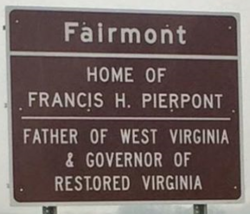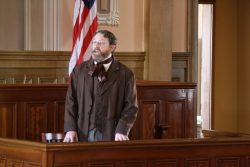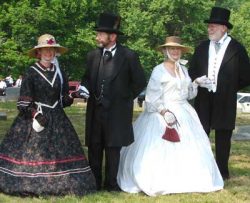Pride In Our Patriarch
January 24, 2017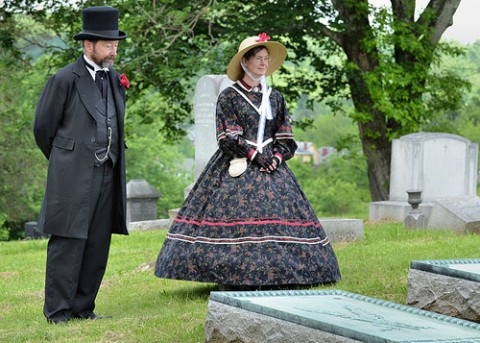
How much do you know about the “Father of West Virginia” besides this often-used designation?
Below are 45 facts about one of Marion County’s most famous forefathers.
1. Francis Pierpont was born January 25, 1814, at the Peirpoint “Plantation” on the Morgantown-Ices Ferry Road, Monongalia County (then Virginia).
2. His middle name, “Harrison,” was added later by his father in honor of his commanding officer, General William Henry Harrison.
3. His mother was the daughter of Morgantown’s founder Zackquill Morgan.
4. Pierpont, the original family name, was altered to Peirpoint in the land office at Richmond, Virginia, in issuing patents for land deeded to his grandfather. Virginia lawyers advised the family that in order to hold their grandfather’s land, they must spell their last name as recorded in the patent. His father used the name Peirpoint throughout all his life. Francis Harrison also utilized Peirpoint throughout most of his adult life, including during his terms as the Civil War and Reconstruction Governor of Virginia.
5. In 1880, when President Garfield appointed him Collector of Internal Revenue, Peirpoint sent his name to the U.S. Senate as Francis H. Pierpont and officially reinstated his name.
6. While Francis was an infant, his family moved to a farm in Marion County and later, when he was 13, to Fairmont.
7. His father built and operated a tannery (leather goods) in Fairmont.
8. He was mostly self-educated.
9. Pierpont graduated from Allegheny College.
10. He taught school in Harrison County.
11. Through his travels, he became an abolitionist after seeing slavery’s abuses in Mississippi.
12. He returned home to Fairmont, ran the family’s tanning business, became active in the Methodist Church, and began studying law.
13. Pierpont was a Republican.
14. He was admitted to the bar at Fairmont on May 2, 1842.
15. In 1848, Pierpont became the local attorney for the Baltimore & Ohio Railroad, serving as a right-of-way attorney in Marion and Taylor counties.
16. He started a coal mine on the family property in 1854.
17. He partnered with coal pioneer James Otis Watson, whose family later controlled Consolidation Coal Company.
18. Before entering politics, he also helped found Fairmont Male and Female Seminary, the precursor to Fairmont State University.
19. Pierpont promoted the creation of “free schools.”
20. On December 26, 1854, Pierpont married Julia Augusta Robertson of Wisconsin.
21. An active supporter of Abraham Lincoln, Pierpont became more involved in politics as an outspoken opponent of Virginia’s secession from the Union.
22. Francis Pierpont was 48 years old when he discovered the plan that gave him the basis for forming the restored government of Virginia and the idea for how a new state could be created.
23. When Virginia seceded and entered the war, delegates from the northwestern counties of Virginia, which refused to join the Confederacy, met at the Wheeling Convention. Declaring that their elected officials had abandoned their posts, a rump government (formed of part, usually a minority, of the legislators initially elected or appointed to office) was established in Wheeling, with Pierpont as the provisional Governor.
24. Pierpont was an antislavery member of the Whig Party.
25. Claiming to be the legitimate government of the entire Commonwealth of Virginia, the “Restored Government” drafted a new Virginia Constitution and sent representatives to the Union Congress. The Second Wheeling Convention met on June 11, 1861, and on June 20, 1861, it unanimously elected Pierpont, governor of the Restored Government of Virginia, with the recognition of President Lincoln.
26. Pierpont was the first and only Governor of the Restored Government of Virginia.
27. Under Pierpont’s leadership, the Wheeling government called for a popular vote on creating a new separate state. Despite a lack of overwhelming support and widespread fraud in the voting process, the Restored Government pressed the U.S. Congress for statehood, which also approved the issue.
28. The new state was named West Virginia and was admitted into the Union in 1863.
29. Arthur I. Boreman was elected Governor of West Virginia, while Pierpont remained Governor of Virginia’s “restored” state.
30. On May 9, 1865, one month after the surrender of the Army of Northern Virginia, President Andrew Johnson appointed Pierpont as the Provisional Governor of Virginia.
31. Pierpont became one of the key figures in the Virginia constitutional convention of 1867-1868, which resulted in the Underwood Constitution of 1869.
32. With the creation of a military government in Virginia under the Military Reconstruction Act of 1867, Pierpont was removed from office on April 4, 1868, by Gen. John Schofield, the Military Governor.
33. Pierpont left Virginia politics and returned to his law practice in West Virginia.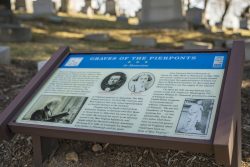
34. Because he supported the statehood movement, Marion County voters elected him to the West Virginia state senate in 1869. Pierpont was not reelected and lost his seat when the Democrats took control of the state.
35. His business partnership with Watson, a Democrat, was dissolved due to political tensions.
36. His last public office was as a collector of Internal Revenue under President James Garfield.
37. Among his youth and young manhood friends were Waitman T. Willey, Gordon Battelle, and John S. Carlile, all of whom played critical roles in the West Virginia statehood movement.
38. After his retirement, he helped create the West Virginia Historical Society.
39. He served as President of the Methodist Protestant Church.
40. He died on March 24, 1899, at his daughter’s home in Pittsburgh.
41. Three years later, his remains were relocated to Woodlawn Cemetery and buried with military rites. He is buried next to his wife Julia and three of their four children.
42. Pierpont’s statue stands in Statuary Hall in the Capitol Building in Washington, one of two West Virginians so recognized.
43. Another statue of Francis H. Pierpont was erected at West Virginia Independence Hall in Wheeling, the first Capitol of Reorganized Virginia and West Virginia’s birthplace.
44. Two Civil War Trail Markers identify essential places in Francis’s life. One remembers his home (located beside the City of Fairmont Public Safety Building) and his final resting place at Woodlawn Cemetery.
45. Visitors can see Pierpont’s original bed, chair, and dresser at the Wilson School Museum in Mannington. (The bed and dresser were given to the Billingslea’s in 1929. The gift was in honor of Normie Bentel and Lula Holloway, whose mother was a housekeeper for Governor Pierpont.)
What were you most surprised to learn about the “Father of West Virginia”?

